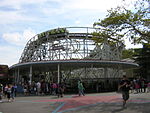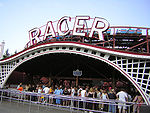Kennywood

Kennywood is an amusement park located in West Mifflin, Pennsylvania, just southeast of Pittsburgh. The park opened on May 30, 1899, as a trolley park attraction at the end of the Mellon family's Monongahela Street Railway. It was purchased in 1906 by F. W. Henninger and Andrew McSwigan, both of whom later formed the family-owned Kennywood Entertainment Company. The company later sold Kennywood, along with four other parks, in 2007 to Parques Reunidos, an international entertainment operator based in Spain. The amusement park features various structures and rides dating back to the early 1900s. Along with Rye Playland Park, it is one of two amusement parks in the United States designated as a National Historic Landmark. Kennywood is also one of thirteen trolley parks in the United States that remain in operation.
Excerpt from the Wikipedia article Kennywood (License: CC BY-SA 3.0, Authors, Images).Kennywood
Kennywood Boulevard,
Geographical coordinates (GPS) Address Website External links Nearby Places Show on map
Geographical coordinates (GPS)
| Latitude | Longitude |
|---|---|
| N 40.3875 ° | E -79.863333333333 ° |
Address
Kennywood Park
Kennywood Boulevard 4800
15122
Pennsylvania, United States
Open on Google Maps










